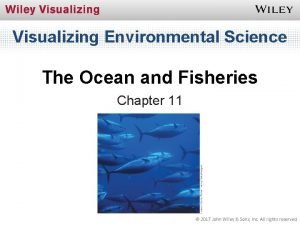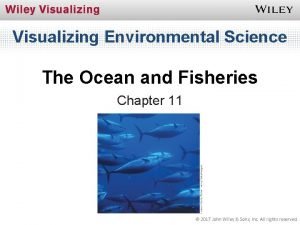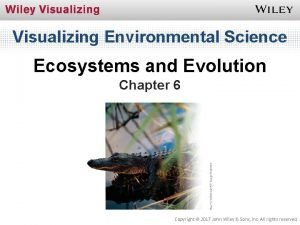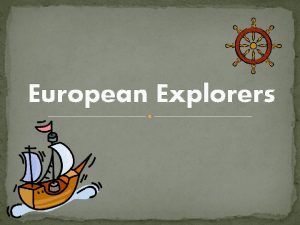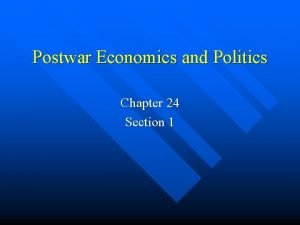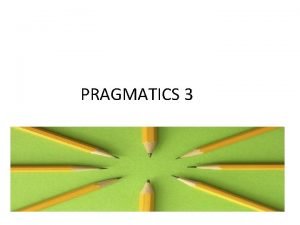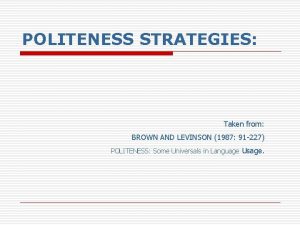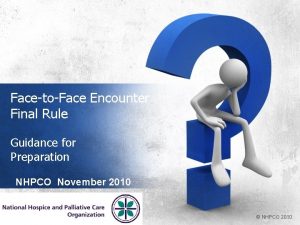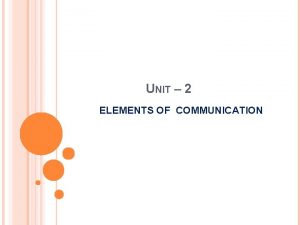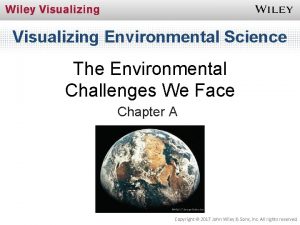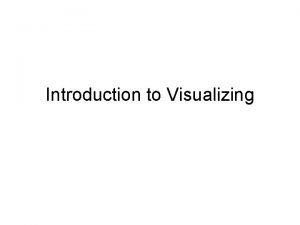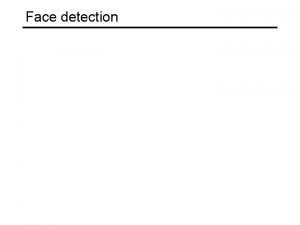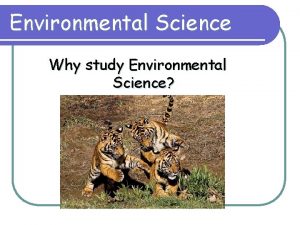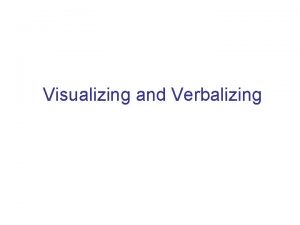Visualizing Environmental Science The Environmental Challenges We Face












- Slides: 12

Visualizing Environmental Science The Environmental Challenges We Face Chapter 1 Copyright © 2017 John Wiley & Sons, Inc. All rights reserved.

A Rapidly Changing World • _______ are the dominant agent of environmental change – Humans transform the ______ – Increasing _________ are overwhelming Earth’s regenerative capacity • Human activities have: – Disrupted ________ of thousands of species • In 2015, a total of 22, 784 species were classified as _______ worldwide – Profound effects on processes such as nutrient cycles and ________ Copyright © 2017 John Wiley & Sons, Inc. All rights reserved.

Human Impacts on the Environment • World population may stabilize by the end of the ______ century – Population experts project anywhere from 7. 7 to 10. 6 billion, depending on how rapidly the _____________ decreases – Current average fertility rate worldwide is _____ children per woman – Fertility rates vary: ______ in highly developed countries compared to ______ in some of the least developed countries – Even with most countries’ active involvement with family planning, population _______ rates take time to change Copyright © 2017 John Wiley & Sons, Inc. All rights reserved.

Human Impacts on the Environment • How many people the Earth can actually support is ____ – This will depend on our ability to develop __________ agricultural practices that do not destroy the biological communities that support life on the planet – Consumption levels of _________________ are also a factor Copyright © 2017 John Wiley & Sons, Inc. All rights reserved.

The Gap Between Rich and Poor Countries • Countries are divided into rich and poor • Rich countries are known as __________ (HDCs) – Highly developed countries represent 18% of the world’s population (US, Canada, ________) – They have complex industrialized bases, _______ rates of population growth, and _____ person incomes. – People in highly developed countries consume _____ resources person than people in developing countries Copyright © 2017 John Wiley & Sons, Inc. All rights reserved.

The Gap Between Rich and Poor Countries – ________________ (MDCs) have: • Medium levels of industrialization (_____ and Turkey) • Lower person incomes, and _____ opportunities for education and health care than those in highly developed countries – _________________ (LDCs) have: • Very _______ person incomes relative to those in highly developed countries (______ and Bangladesh) • Low levels of industrialization, most economies are ___________ • ______ population growth and infant mortality rates Copyright © 2017 John Wiley & Sons, Inc. All rights reserved. • Hunger, disease, and _________ are common

Population, Resources, and the Environment • The high rate of ________ consumption in highly developed countries affects the environment as much as rapid population growth in other parts of the world – During rapid population _______, simply providing the essentials for survival can overwhelm a country’s natural resources • Often a situation found in developing countries • In ____ developed countries, consumption of natural resources far exceeds amounts needed for basic survival – This depletion of resources extends past the boundaries of individual countries and can affect resources _______ • Continued high-consumption lifestyles now rely on _______ of resources from less developed countries to sustain them Copyright © 2017 John Wiley & Sons, Inc. All rights reserved.

Population, Resources, and the Environment • Ecological footprint: – Amount of productive land, fresh air/water, and ocean, required to supply _______ person with food, wood, energy, _____, housing, clothing, transportation, and waste disposal – Allotted global footprint ______ acres • (Amount of Earth’s productive land water ÷ Global human population) – Average global footprint ______ acres • This results in an ecological overshoot Copyright © 2017 John Wiley & Sons, Inc. All rights reserved.

Sustainability and the Environment • Sustainability: – The ability to meet humanity’s current _____ without _________ future generations’ ability to meet their needs • Currently, human society is ______ operating sustainably, due to: – Use of __________ resources as if they were unlimited – Use of renewable resources ______ than they can be replenished – We are _________ the environment with toxins as if its capacity to absorb them was limitless – Population continues to _________ – Human ________ disrupt many natural regenerative processes Copyright © 2017 John Wiley & Sons, Inc. All rights reserved.

Global Environmental Issues • While climate variation is normal, global temperatures are ________ at an unprecedented rate. • The removal of _______ is disrupting ecosystems. • The ______ are being polluted and people are overfishing. • Incorrect animal grazing and agriculture practices are causing fertile land to become _______. • The ____________, which protects us from harmful radiation, is thinning in certain areas. Copyright © 2017 John Wiley & Sons, Inc. All rights reserved.

Environmental Science • Interdisciplinary study of humanity’s ______ with other organisms and the physical environment – Combines information from many fields • Biology, ______, geology, geography, ________, economics, sociology (including demography), cultural anthropology, agriculture, engineering, law, politics, and ethics. • The Goals of Environmental Science • Establish general principles about how the _______ world functions • Develop viable ________ to environmental problems • Identify, understand, and solve problems that we as a _______ have created • Focus on solving problems based on ______ knowledge Copyright © 2017 John Wiley & Sons, Inc. All rights reserved.

Science as a Process • ___________: – The way a scientist approaches a problem, by formulating a _______ and then testing it – Five steps (see chart) Copyright © 2017 John Wiley & Sons, Inc. All rights reserved.
 Visualizing environmental science solution manual
Visualizing environmental science solution manual Visualizing environmental science solution manual
Visualizing environmental science solution manual Visualizing environmental science (doc or html) file
Visualizing environmental science (doc or html) file Tragedy of the commons
Tragedy of the commons What challenges did madison face abroad
What challenges did madison face abroad What obstacles did vasco nunez de balboa face
What obstacles did vasco nunez de balboa face Chapter 2 population and health key issue 3
Chapter 2 population and health key issue 3 What challenges did calvin coolidge face
What challenges did calvin coolidge face What's your favourite subject
What's your favourite subject Attributable silence
Attributable silence Negative politeness examples
Negative politeness examples Face-to-face narrative examples
Face-to-face narrative examples Elements and types of communication
Elements and types of communication
